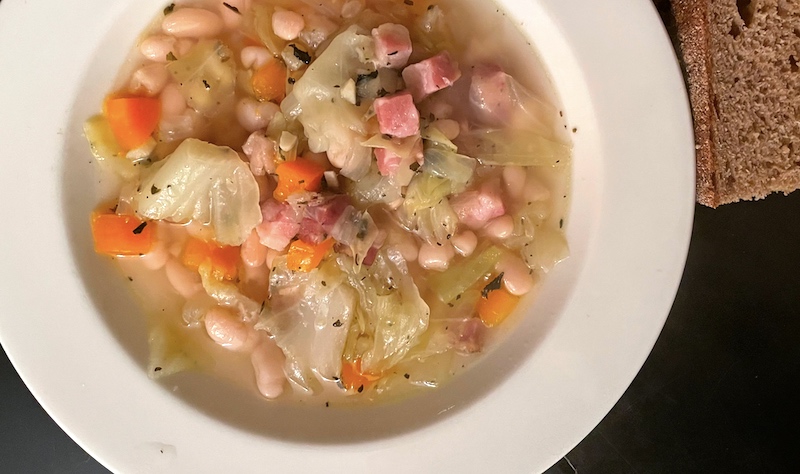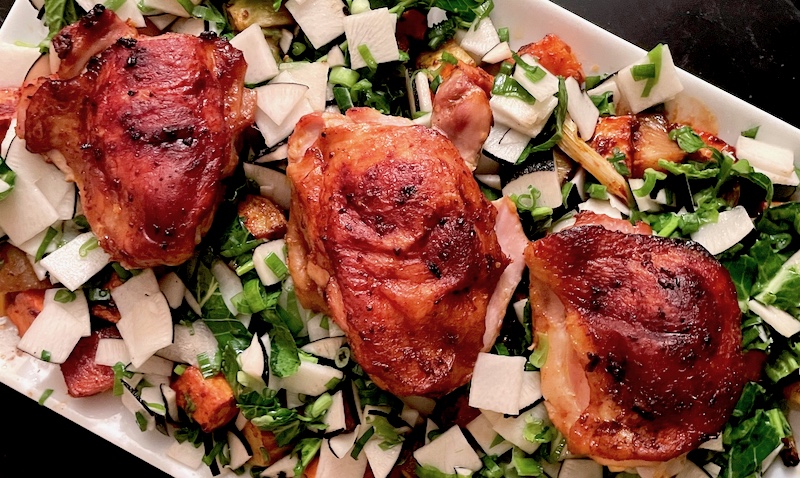
Sheet Pan Supper: Gochujang Root Vegetables with Chicken Thighs
synchronicity Noun; pron: syn·chro·nic·i·ty, siŋ-krə-ˈni-sə-tē; plural: synchronicities
1: the quality or fact of being synchronous.
2: the coincidental occurrence of events.
I love it when I'm walking with a friend—in this instance with my neighbor Ann, a professor of Asian art history, a professional soprano and an expert plantswoman—and we're talking, as we often do, about a favorite recipe. In this case, it was a sheet pan supper she'd made recently and, as we rambled behind our dogs through the neighborhood, I realized I had all the main ingredients in my fridge to make it that night.
Synchronicity, indeed!
When I arrived home I looked up the recipe online and found it was by New York Times writer Yewande Komolafe, who wrote "this recipe calls for a wintry mix of squash and turnips, but equal amounts of root vegetables like carrots, potatoes and beets, or lighter vegetables like cauliflower, brussels sprouts or broccoli will work well, too."
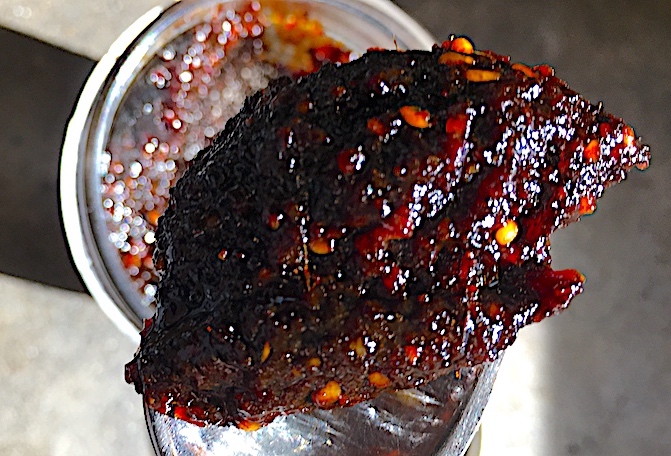
I had two very large garnet yams and two medium-sized rutabagas on hand, so I had roots aplenty, plus some carrots I'd just pulled from my neighbor Bill's garden earlier that day. The rutabagas still had their hefty leaves attached, so I chopped those up into bite-sized pieces, too, and threw them in with the rest of the vegetables.
Of course I had the exceptional gochujang I'd made from my friend Denise's family recipe, and I tweaked the NYT recipe by adding several cloves of garlic, a spoonful of locally made Jorinji miso and a couple of glugs of fish sauce to the sauce, plus a splash of fish sauce in the salad dressing.
The real genius of this recipe—thank you, Ms. Komolafe, I'll now be doing this with other dishes—is topping the roasted vegetables with a salad of lightly pickled radishes and scallion greens just before serving. I lucked out there, too, by pulling from my veg bin a gorgeous black radish from that selfsame CSA share.
If you have all the ingredients on hand, so much the better, but this is worth shopping for, too, and comes together in about an hour, most of which is roasting time
Gochujang Roasted Root Vegetables and Chicken Thighs
For the roasted vegetables and chicken:
3 Tbsp. gochujang*
2 Tbsp. soy sauce
1 Tbsp. fish sauce
1 (1-inch) piece fresh ginger, peeled and finely grated (about 1 tablespoon)
1 Tbsp. white miso
4 large cloves garlic, pressed in a garlic press
3 Tbsp. vegetable oil
2 lbs. garnet yams and rutabaga chopped into 1-inch pieces, about 5 loose cups (see above to substitute other vegetables)
10 scallions, roots trimmed, green and white/light green parts separated, sliced into 3" lengths
Kosher salt
3-4 good-sized, bone-in, skin-on chicken thighs
For the salad:
1 bunch radishes, about 10 oz., or 1 med. large black radish, trimmed and thinly sliced
2 Tbsp. rice vinegar
1 Tbsp. sesame oil
1/2 tsp. fish sauce
Heat the oven to 425°.
Combine the gochujang, soy sauce, fish sauce, miso, ginger, pressed garlic and vegetable oil in a zip-lock bag. Add the yams, rutabagas and scallion whites (reserving the darker greens for the salad), and shake to coat with sauce. Transfer to a rimmed baking sheet. Season the chicken with salt and toss to coat in whatever is left of the glaze in the bag. Arrange the chicken pieces skin-side up between the vegetables on the sheet. Roast until vegetables are tender, chicken is cooked through and the skin crispy and browned in spots, about 40 minutes.
While the chicken cooks, thinly chiffonade the scallion greens crosswise. Cut the radishes into thin rounds. If using a black radish, cut into approx. 1" sticks and slice thinly crosswise (do not peel—that black skin is very dramatic). In a small bowl, toss the sliced scallion greens and radishes with the rice vinegar, sesame oil and fish sauce. Season to taste with salt and set aside to lightly pickle, stirring occasionally to distribute dressing evenly.
When chicken and vegetables are done, remove the chicken to a plate and transfer vegetables to a platter. Quickly top vegetables with the drained quick-pickled salad, then place chicken thighs on top.
The recipe suggests serving this with steamed rice, but to me, root vegetables are generally fairly starchy, so I didn't feel it needed the rice.
* If you don't want to make your own gochujang, I've found Mother-in-Law's is a decent brand, but won't have nearly the depth of flavor you'll get from homemade.


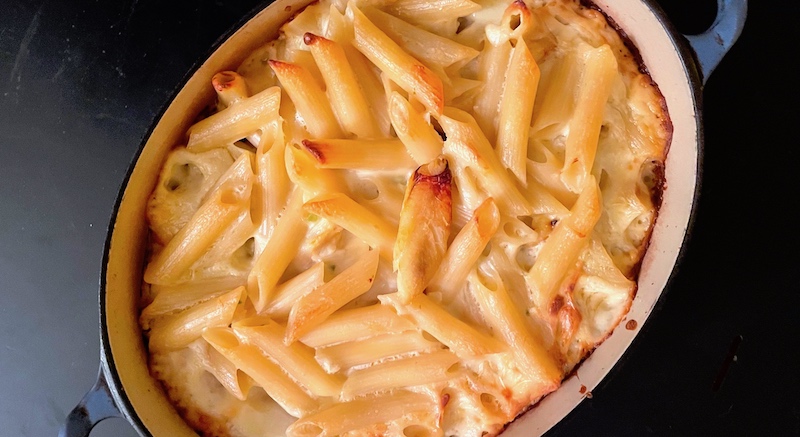
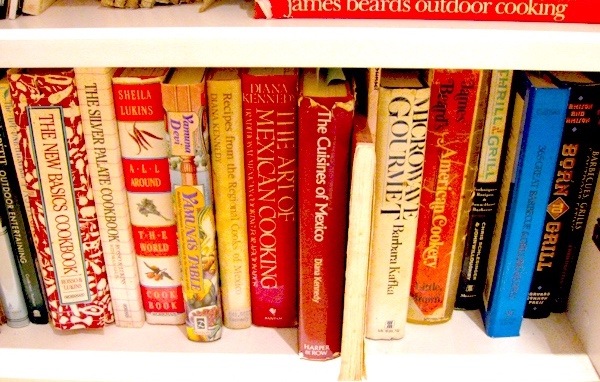 But I propose a different way to categorize a cookbook, and that's by how you feel. Happy? Make some small plates of your favorite foods, including simple salads and desserts. Depressed? You could indulge in a big ol' chocolate cake by yourself, or treat your mood with lots of fish and kale for their Omega 3s and anti-oxidants.
But I propose a different way to categorize a cookbook, and that's by how you feel. Happy? Make some small plates of your favorite foods, including simple salads and desserts. Depressed? You could indulge in a big ol' chocolate cake by yourself, or treat your mood with lots of fish and kale for their Omega 3s and anti-oxidants.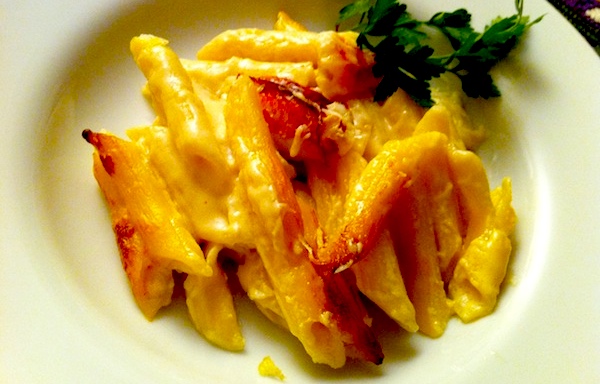 Which is why, when I saw that cooked whole crabs had hit a ridiculously low price per pound, and knowing that early season crab is the sweetest, I bought two and fantasized about using it in macaroni and cheese. While I was only planning on using the meat from one of them for the casserole, the price and my lack of inhibitions made me throw the meat from both into the noodles and sauce just before I slid it into the oven, and it was so worth it.
Which is why, when I saw that cooked whole crabs had hit a ridiculously low price per pound, and knowing that early season crab is the sweetest, I bought two and fantasized about using it in macaroni and cheese. While I was only planning on using the meat from one of them for the casserole, the price and my lack of inhibitions made me throw the meat from both into the noodles and sauce just before I slid it into the oven, and it was so worth it.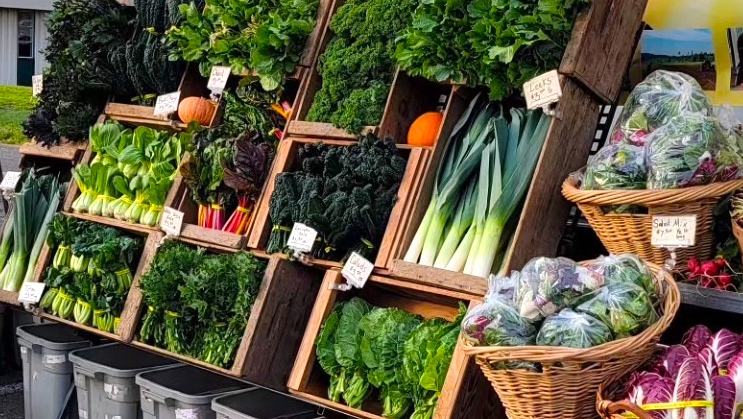
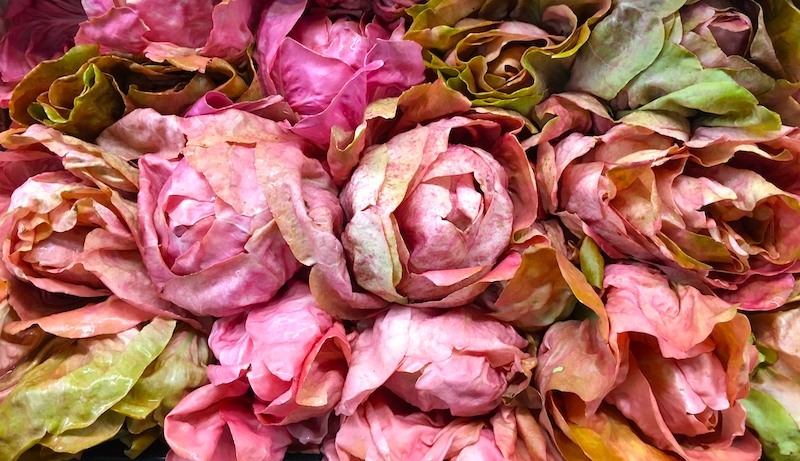
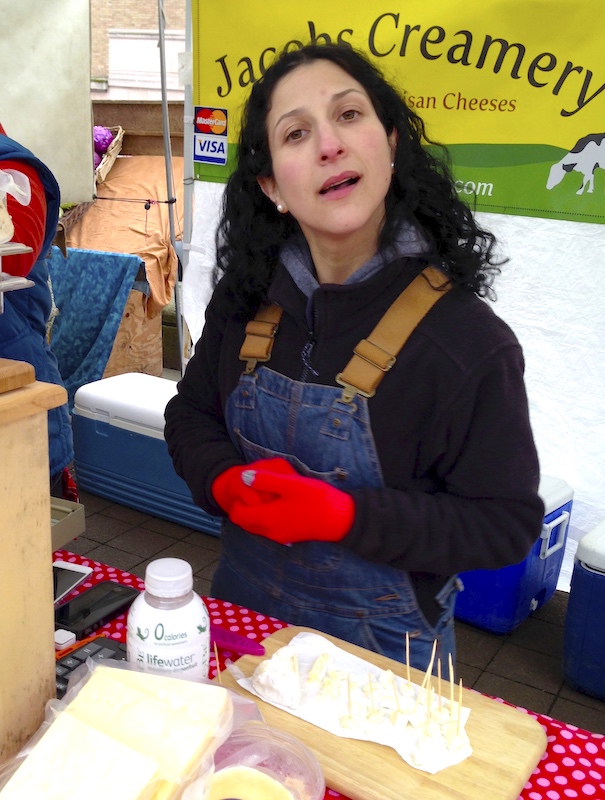
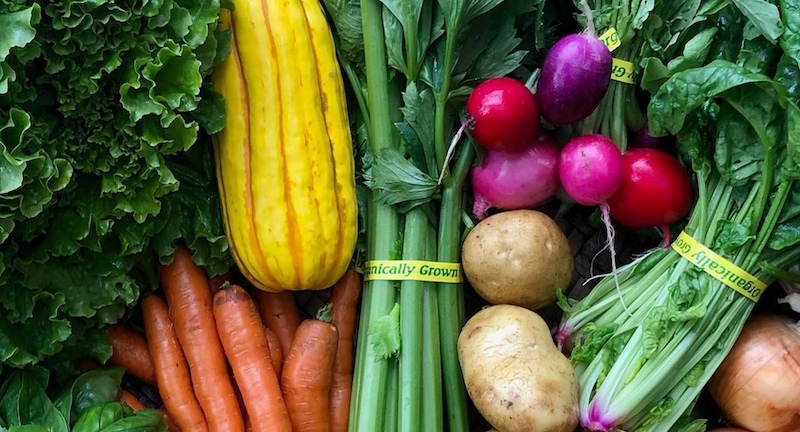
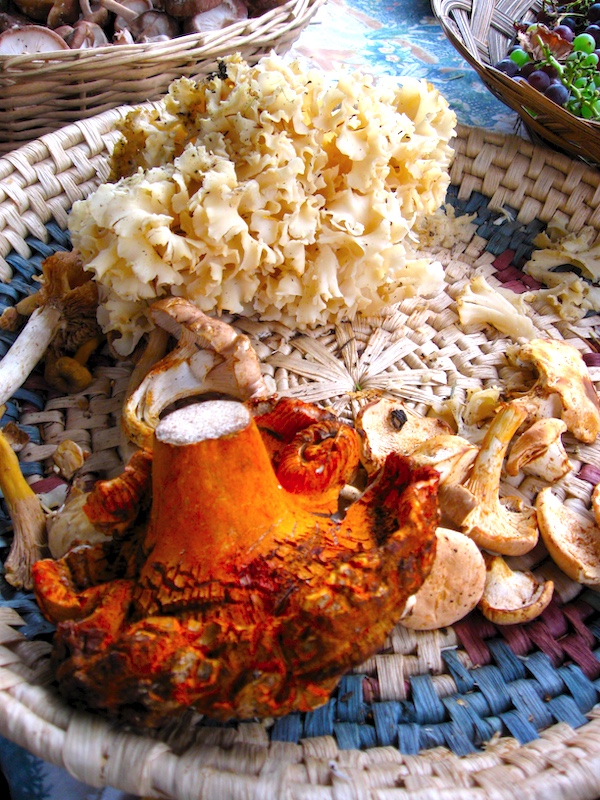
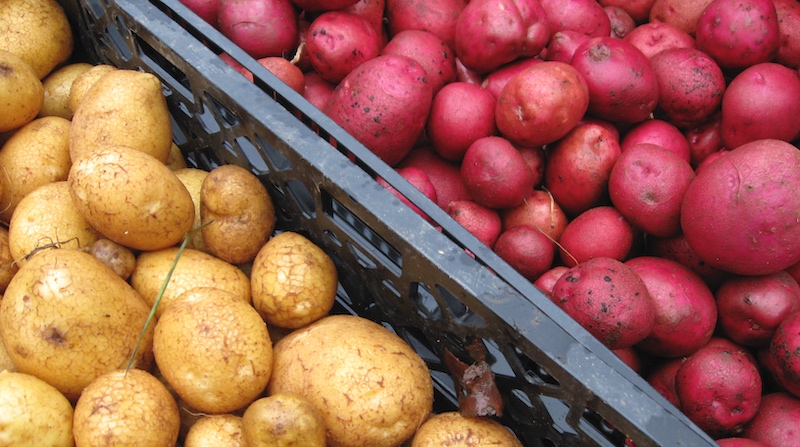
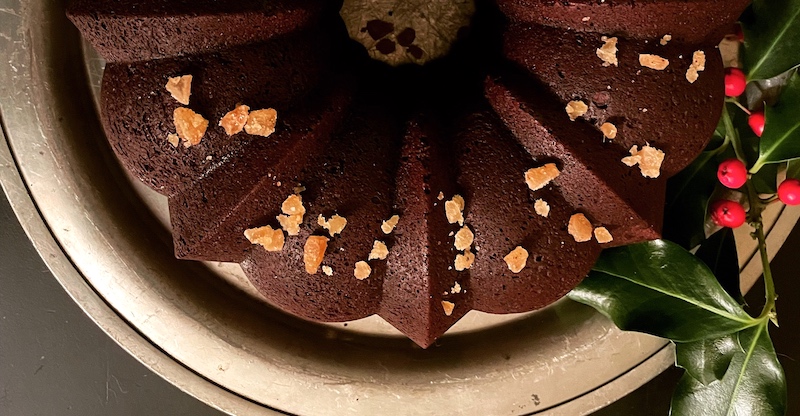
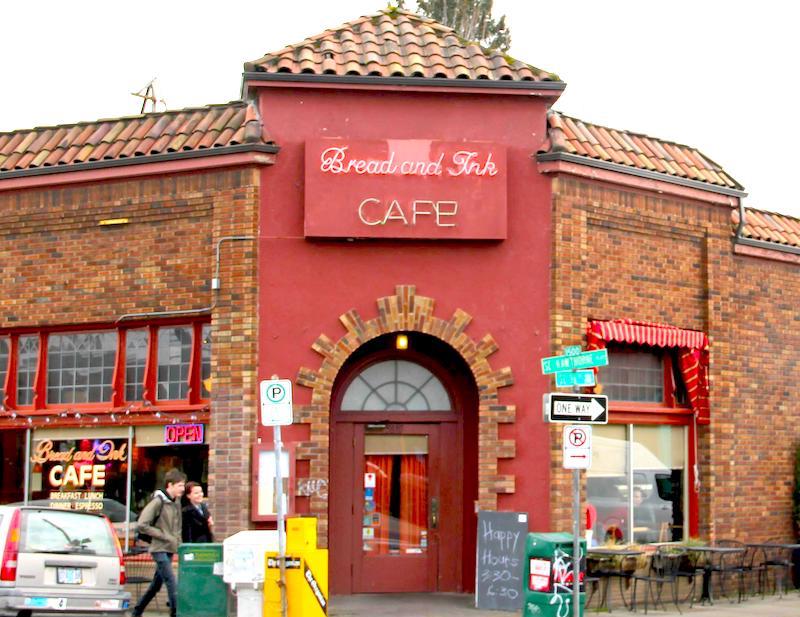

 And indeed they did! I’ve never been at a gathering as truly diverse as this one—people young and older, from just about every part of the world, of every hue, and dozens of nationalities. Lucky for me, all speaking English albeit with the chiaroscuro of both their first language and the accent of whoever schooled them in English.
And indeed they did! I’ve never been at a gathering as truly diverse as this one—people young and older, from just about every part of the world, of every hue, and dozens of nationalities. Lucky for me, all speaking English albeit with the chiaroscuro of both their first language and the accent of whoever schooled them in English. I certainly wasn’t the only person among the 2,500 futurists who centers on healthy ecosystems—including healthy, prosperous humans, of course—but it’s also true that many of the panels and discussions at the conference were about shiny new things. Shiny new tools, shiny new technologies, shiny new approaches to problems. I told anyone who would listen that I’m not opposed to the new and shiny—unless those innovations are aimed at hacking the natural world for the convenience of humans.
I certainly wasn’t the only person among the 2,500 futurists who centers on healthy ecosystems—including healthy, prosperous humans, of course—but it’s also true that many of the panels and discussions at the conference were about shiny new things. Shiny new tools, shiny new technologies, shiny new approaches to problems. I told anyone who would listen that I’m not opposed to the new and shiny—unless those innovations are aimed at hacking the natural world for the convenience of humans.
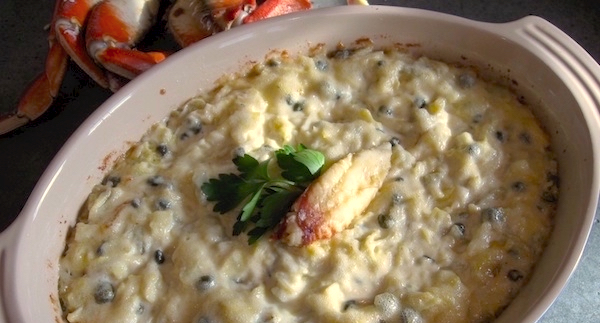 Hot Artichoke and Crab Dip
Hot Artichoke and Crab Dip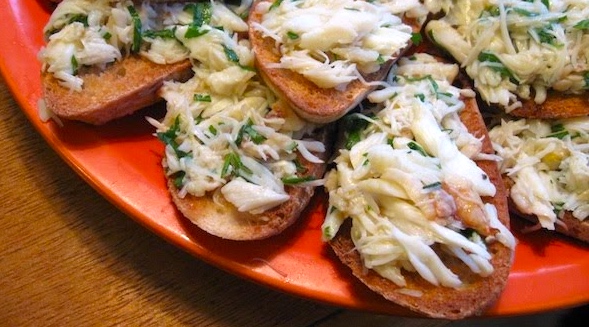 Crab Crostini
Crab Crostini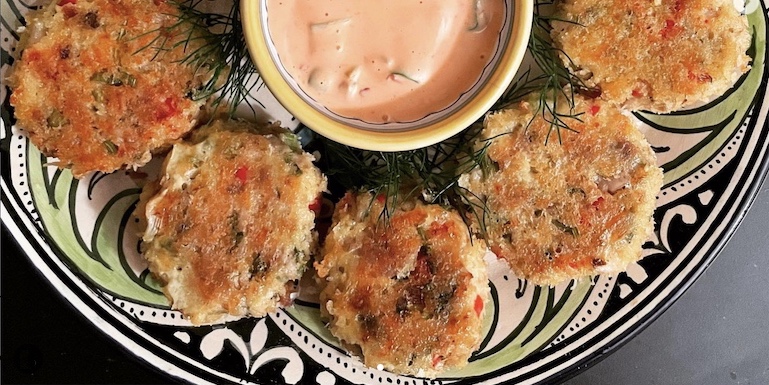 Michel's Thai-ish Crab Cakes
Michel's Thai-ish Crab Cakes



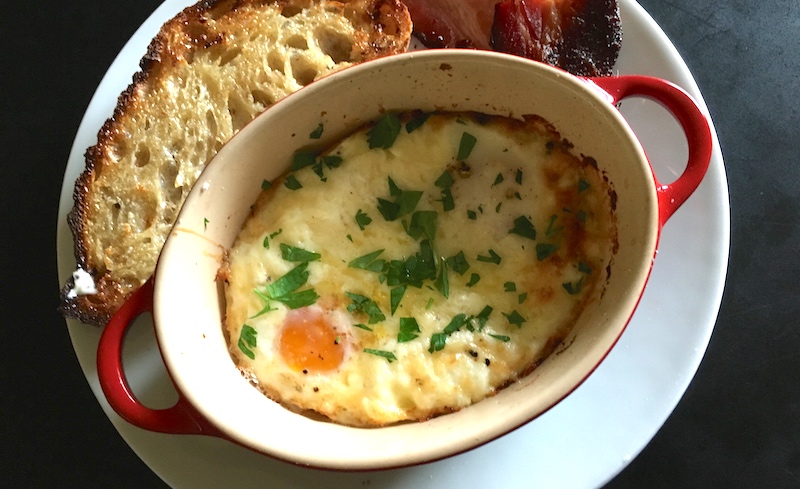
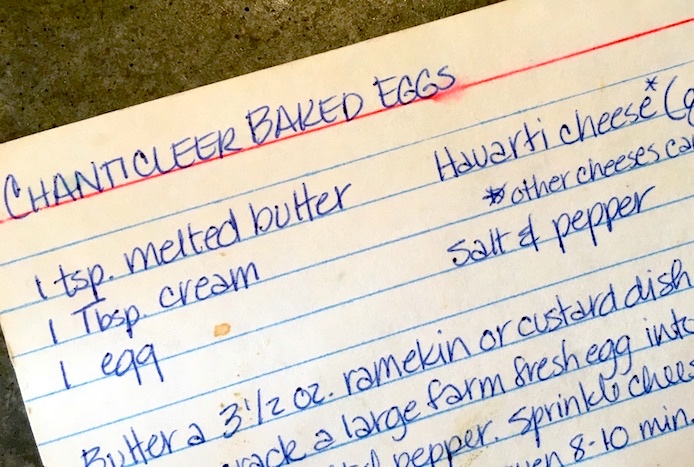 Now, a dish can burrow its way into your brain for lots of reasons—a romantic setting, great company, a few too many mimosas—but this one was alluring because of its simplicity. Just butter, eggs, cream and cheese baked to a golden finish, crispy yet creamy, the yolks still oozing.
Now, a dish can burrow its way into your brain for lots of reasons—a romantic setting, great company, a few too many mimosas—but this one was alluring because of its simplicity. Just butter, eggs, cream and cheese baked to a golden finish, crispy yet creamy, the yolks still oozing.



